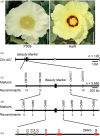Increasing floral visitation and hybrid seed production mediated by beauty mark in Gossypium hirsutum
- PMID: 35266277
- PMCID: PMC9241374
- DOI: 10.1111/pbi.13805
Increasing floral visitation and hybrid seed production mediated by beauty mark in Gossypium hirsutum
Abstract
Hybrid crop varieties have been repeatedly demonstrated to produce significantly higher yields than their parental lines; however, the low efficiency and high cost of hybrid seed production has limited the broad exploitation of heterosis for cotton production. One option for increasing the yield of hybrid seed is to improve pollination efficiency by insect pollinators. Here, we report the molecular cloning and characterization of a semidominant gene, Beauty Mark (BM), which controls purple spot formation at the base of flower petals in the cultivated tetraploid cotton species Gossypium barbadense. BM encodes an R2R3 MYB113 transcription factor, and we demonstrate that GbBM directly targets the promoter of four flavonoid biosynthesis genes to positively regulate petal spot development. Introgression of a GbBM allele into G. hirsutum by marker-assisted selection restored petal spot formation, which significantly increased the frequency of honeybee visits in G. hirsutum. Moreover, field tests confirmed that cotton seed yield was significantly improved in a three-line hybrid production system that incorporated the GbBM allele. Our study thus provides a basis for the potentially broad application of this gene in improving the long-standing problem of low seed production in elite cotton hybrid lines.
Keywords: Gossypium barbadense; Gossypium hirsutum; Beauty Mark; MYB; hybrid seed yield.
© 2022 The Authors. Plant Biotechnology Journal published by Society for Experimental Biology and The Association of Applied Biologists and John Wiley & Sons Ltd.
Conflict of interest statement
The authors declare no competing interests.
Figures








References
-
- Chen, Y. , Rivlin, A. , Lange, A. , Ye, X. , Vaghchhipawala, Z. , Eisinger, E. , Dersch, E. et al. (2014) High throughput Agrobacterium tumefaciens‐mediated germline transformation of mechanically isolated meristem explants of cotton (Gossypium hirsutum L.). Plant Cell Rep. 33, 153–164. - PubMed
-
- Dai, J. and Dong, H. (2014) Intensive cotton farming technologies in China: achievements, challenges and countermeasures. Field Crops Res. 155, 99–110.
-
- Dell'Olivo, A. and Kuhlemeier, C. (2013) Asymmetric effects of loss and gain of a floral trait on pollinator preference. Evolution, 67, 3023–3031. - PubMed
-
- Dubos, C. , Stracke, R. , Grotewold, E. , Weisshaar, B. , Martin, C. and Lepiniec, L. (2010) MYB transcription factors in Arabidopsis . Trends Plant Sci. 15, 573–581. - PubMed
-
- Eaton, F.M. (1955) Physiology of the cotton plant. Annu. Rev. Plant Physiol. 6, 299–328.
Publication types
MeSH terms
LinkOut - more resources
Full Text Sources

